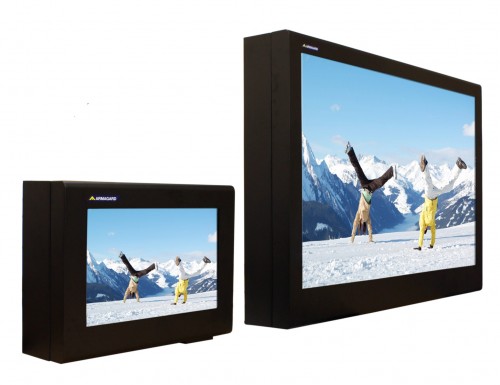Winter and Outdoor Digital Signage
Posted by: Richard Williams | Posted on: | 2 Comments
Outdoor digital signage is an effective form of communication. One of its major benefits is that an outdoor screen continues to display content day and night, spreading the message 24 hours a day, 365 days of the year. This poses many challenges for outdoor digital signage as any screen expected to function throughout the year, needs to cope with the varying temperatures of the seasons.
 While many outdoor digital signage systems are designed with wide operating temperature ranges, a lot of emphasis is placed on keeping screens cool; after all, it’s very easy for an LCD screen to overheat, especially during the high temperatures of summer. However, as equally disabling for a modern LCD screen is winter, and all too often not enough protection is afforded to outdoor digital signage to cope with the extreme cold that some locations can suffer from during the winter months.
While many outdoor digital signage systems are designed with wide operating temperature ranges, a lot of emphasis is placed on keeping screens cool; after all, it’s very easy for an LCD screen to overheat, especially during the high temperatures of summer. However, as equally disabling for a modern LCD screen is winter, and all too often not enough protection is afforded to outdoor digital signage to cope with the extreme cold that some locations can suffer from during the winter months.
While most outdoor screens are deigned to cope with normal winter temperatures, during extreme, freak winters where temperatures really plummet, or in locations that suffer extremely harsh winters, many outdoor digital signage displays simply can’t cope.
The extreme cold has several effects on electrical equipment such as LCD screens. Firstly, when temperatures drop below freezing it causes contraction of metals, this leads to damage of circuits and electronic components. The extreme cold also causes metals and wiring to become brittle, which leads to breakages. Finally, any condensation inside the screen enclosure expands when it freezes, causing further damage to components and circuitry.
When functioning, LCD screens do provide their own heat, and this can provide one of the best defences against cold temperatures. By using a form of insulation inside the digital signage enclosure, retention of this heat can help keep internal temperatures above freezing. Of course, some locations require even further defence against the cold. However, it is also important to remember that any outdoor screen that functions in cold weather may also have to function in the warmer temperatures of the summer too.
Thermostatically controlled heaters provide the best winter weather defence as they only switch on when temperatures drop to set levels. This means that any screen that functions in extremely cold conditions can have enough protection to prevent damage due to freezing, but the screen can also function throughout the warmer months too.
Another consideration when using heaters and other cold weather components is to ensure that condensation doesn’t cause any problems in screen readability. You may have experienced a similar problem when getting into a cold car during the winter. Very quickly, the windscreen fogs up and you need to employ the car’s heaters to keep the screen clear. Well, similar systems can be employed on outdoor digital signage screens, using a curtain of warm air to ensure the face of the screen doesn’t fog up during the colder weather.
Post shortlink:
Popular Products
LCD Enclosure
Need armor for your LCD/LED screen(s)? Outdoors or inside the versatile LCD enclosure protects against thieves, vandals & the weather. Installation idea: NFL stadiums.
Outdoor Digital Signage
Exclusive 46” outdoor screen protection. Dubbed the ‘Totem’, due to its distinct design, it repels damage threats, but attracts audiences. Installation idea: Drive-thru restaurants.
Portrait Flat Panel Enclosure
Safeguard your eye-level advertising display screen(s), indoors or outdoors. Completely customizable, add exciting features like touch screen technology. Installation idea: Restaurant frontages.
Indoor Digital Signage
Popular purchase for retail outlets! Great for ‘point of sale’ persuasion, boost your brand with static & motion advertising from a single unit! Installation idea: Mall of America.




